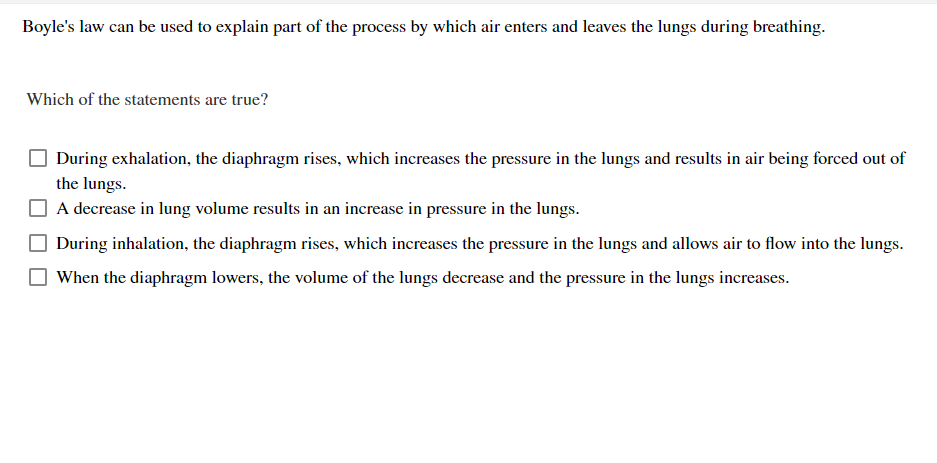Boyle's law can be used to explain part of the process by which air enters and leaves the lungs during breathing. Which of the statements are true? During exhalation, the diaphragm rises, which increases the pressure in the lungs and results in air being forced out of the lungs. A decrease in lung volume results in an increase in pressure in the lungs. During inhalation, the diaphragm rises, which increases the pressure in the lungs and allows air to flow into the lungs. When the diaphragm lowers, the volume of the lungs decrease and the pressure in the lungs increases.
Boyle's law can be used to explain part of the process by which air enters and leaves the lungs during breathing. Which of the statements are true? During exhalation, the diaphragm rises, which increases the pressure in the lungs and results in air being forced out of the lungs. A decrease in lung volume results in an increase in pressure in the lungs. During inhalation, the diaphragm rises, which increases the pressure in the lungs and allows air to flow into the lungs. When the diaphragm lowers, the volume of the lungs decrease and the pressure in the lungs increases.
Introduction to General, Organic and Biochemistry
11th Edition
ISBN:9781285869759
Author:Frederick A. Bettelheim, William H. Brown, Mary K. Campbell, Shawn O. Farrell, Omar Torres
Publisher:Frederick A. Bettelheim, William H. Brown, Mary K. Campbell, Shawn O. Farrell, Omar Torres
Chapter5: Gases, Liquids, And Solids
Section: Chapter Questions
Problem 5.111P: 5-111 Diving, particularly SCUBA (Self-Contained Underwater Breathing Apparatus) diving, subjects...
Related questions
Question

Transcribed Image Text:Boyle's law can be used to explain part of the process by which air enters and leaves the lungs during breathing.
Which of the statements are true?
During exhalation, the diaphragm rises, which increases the pressure in the lungs and results in air being forced out of
the lungs.
A decrease in lung volume results in an increase in pressure in the lungs.
During inhalation, the diaphragm rises, which increases the pressure in the lungs and allows air to flow into the lungs.
When the diaphragm lowers, the volume of the lungs decrease and the pressure in the lungs increases.
Expert Solution
This question has been solved!
Explore an expertly crafted, step-by-step solution for a thorough understanding of key concepts.
This is a popular solution!
Trending now
This is a popular solution!
Step by step
Solved in 3 steps

Knowledge Booster
Learn more about
Need a deep-dive on the concept behind this application? Look no further. Learn more about this topic, chemistry and related others by exploring similar questions and additional content below.Recommended textbooks for you

Introduction to General, Organic and Biochemistry
Chemistry
ISBN:
9781285869759
Author:
Frederick A. Bettelheim, William H. Brown, Mary K. Campbell, Shawn O. Farrell, Omar Torres
Publisher:
Cengage Learning

Chemistry & Chemical Reactivity
Chemistry
ISBN:
9781337399074
Author:
John C. Kotz, Paul M. Treichel, John Townsend, David Treichel
Publisher:
Cengage Learning

Chemistry & Chemical Reactivity
Chemistry
ISBN:
9781133949640
Author:
John C. Kotz, Paul M. Treichel, John Townsend, David Treichel
Publisher:
Cengage Learning

Introduction to General, Organic and Biochemistry
Chemistry
ISBN:
9781285869759
Author:
Frederick A. Bettelheim, William H. Brown, Mary K. Campbell, Shawn O. Farrell, Omar Torres
Publisher:
Cengage Learning

Chemistry & Chemical Reactivity
Chemistry
ISBN:
9781337399074
Author:
John C. Kotz, Paul M. Treichel, John Townsend, David Treichel
Publisher:
Cengage Learning

Chemistry & Chemical Reactivity
Chemistry
ISBN:
9781133949640
Author:
John C. Kotz, Paul M. Treichel, John Townsend, David Treichel
Publisher:
Cengage Learning

Introductory Chemistry: A Foundation
Chemistry
ISBN:
9781337399425
Author:
Steven S. Zumdahl, Donald J. DeCoste
Publisher:
Cengage Learning

Chemistry for Engineering Students
Chemistry
ISBN:
9781337398909
Author:
Lawrence S. Brown, Tom Holme
Publisher:
Cengage Learning

Chemistry: The Molecular Science
Chemistry
ISBN:
9781285199047
Author:
John W. Moore, Conrad L. Stanitski
Publisher:
Cengage Learning